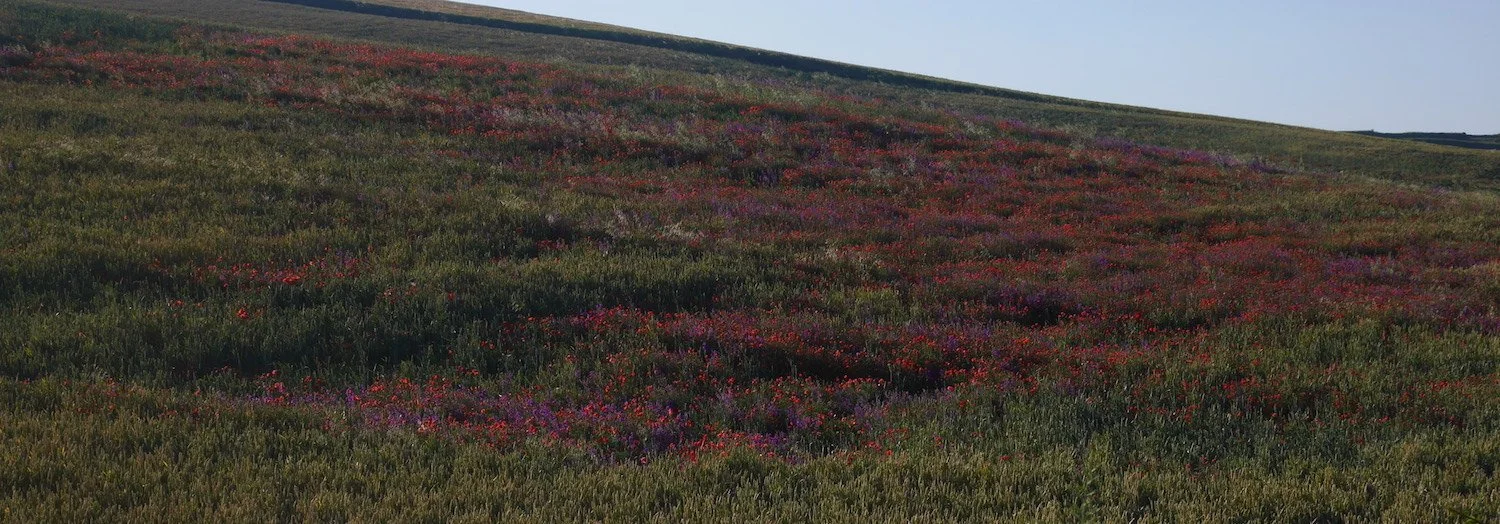Sites along the way. Image adapted from Google Earth.
The ascent from the fields near Atapuerca was not long but it was steep. La Sierra de Atapuerca was the last speed bump before Spain’s central plateau.
We joined scrub forest and rocky ridges climbing the slope. Underfoot, small oaks pushed upward, resilient in their battle against deforestation. I wondered what this area would have looked like in the days of Homo antecessor (see post here).*
Small oaks pushed upward.
Almost on cue, a deer darted across the trail. Bob cried out, “Look!”
It was small, stocky, and grayish-brown in color. It belonged to the family of European roe deer (Capreolus capreolus), the most common cervid in the Mediterranean basin.
“For I shall bring you crimson leaves
And rippling wheat in golden sheaves;
A cache of berries, red and sweet,
And dappled deer on silent feet.”**
If the European roe deer is the (pū́gargos)—literally “white rump”—of the classical sources, our sighting may have a biblical connection.*** The Greek translation of the Old Testament considers the pū́gargos among a list of animals dubbed “clean” or kosher for eating.
Capreolus capreolus, male and female. Image from here (accessed 1/22/2022)
This one didn’t look so edible to me. He was scrawny and dirty. He was fast though, faster than my hand and camera. How did ancient hunters counter such speed? Stealth? Cooperation? Thrusting spears? Darts in atlatls? Hunting dogs?
To halloo the hounds and chase the dappled deer.****
The less speedy hunters of Atapuerca. Somebody had to stay home and protect the village.
At the summit of the Sierra de Atapuerca (about 3,500 feet), we came upon a tall cross or cruceiro. Such monuments are regularly found along the Camino Francés. The summit offered a magnificent view of Spain’s central plateau. The distant outlines of the modern city of Burgos were visible. Our goal was to make it there tomorrow.
The cross at the trail summit.
We descended on steep scree and walked the last few miles to Cardeñuela Riopico. There, a colorful bus caught our eye. We signaled, pulled off the trail, and stopped for the night.
How could we not stop at an albergue with a double decker bus as a billboard?
Albergue vía Minera was one of the more memorable hostels in our Spanish experience. And speaking of Spanish and French and German and Italian, Bob and I were the only native English speakers at the pilgrim table that night. We enjoyed a fine meal and conversation. I don’t recall what the meat was (nor much of the conversation!), but I know it wasn’t venison.
¡Buen Camino!
We shared a pilgrim meal that evening with our new European friends.
*According to Blondel and Aronson, many tropical species disappeared in the middle Pleistocene. The shifting climate allowed for the “settling in” of modern faunas, including true bison (Bison schoetensacki), reindeer (Rangifer tarandus), red deer (Cervus elaphus), and roe deer (Capreolus). See their Biology and Wildlife of the Mediterranean Region, Oxford, 1999: 43.
A project of interest in the region is Paleolítico Vivo or “Living Paleolithic.” This conservation organization is attempting (among other things) to “rewild” the area of Atapuerca by introducing ancient species such as the wild ox (aurochs), bison, and Przewalski's horse. See their webpage here (accessed 1/22/2022).
**Lauren Willig, from “Garden Intrigue—Miss Gwen” (posted here February 11, 2012).
***The Greek term πύγαργος (pū́gargos), literally “white rump,” is used to describe some kind of ungulate. In the Biblical text, Deut 14:4-5 describes animals that may be eaten by the ancient Israelites: “the ox, the sheep, the goat, the deer, the gazelle, the roebuck, the wild goat, the πύγαργος (pū́gargos), the antelope, and the mountain sheep.” Others believe the pū́gargos of antiquity is the addax. Hebrew source uses יַחְמוּר (yahmur) in Deut 14:5 to describe the roebuck.
Curiously, in 1 Kings 5:3, the more familiar Greek term δορκᾰ́ς (dorkas) for “deer” or “gazelle” is used to translate yahmur. How do we distinguish between pū́gargos and dorkas?
****From Plutarch, On the Intelligence of Animals 1.20. See the link here (accessed 1/23/2022).
This drawing depicts a happy pilgrim on the way to the Albergue vía Minera in Cardeñuela Riopico, Spain. Note the lovely fountain in the yard and the peaceful enclosure of the albergue. I don’t know who the artist was or who produced this, but it was proudly hung on the wall in the hostel.
All the Camino experiences described here took place in the summer of 2018 and were reconstructed for this blog from my notes, photographs, and memories.








